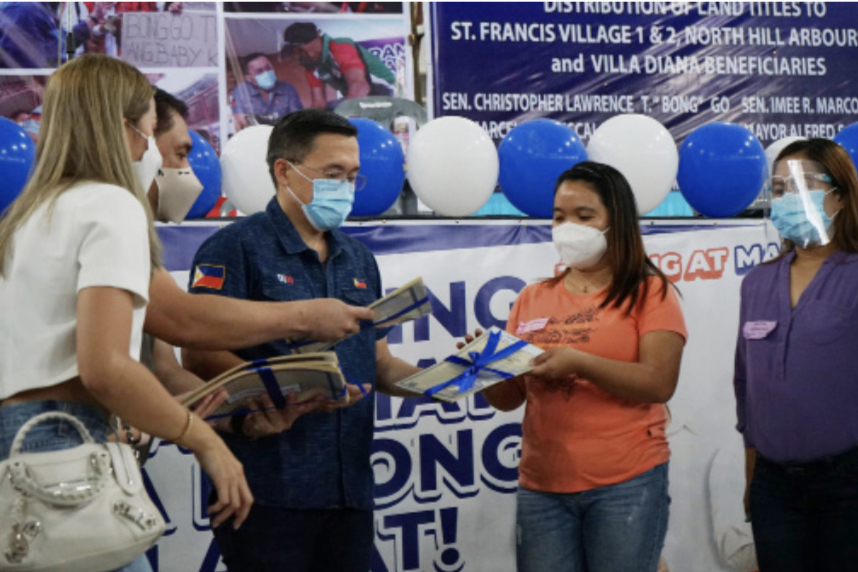RCSP starts deployment of teams to selected municipalities
CATARMAN, Northern Samar – A simultaneous send-off ceremony for Retooled Community Support Program (RCSP) teams was held today, March 22, 2021, at the Northern Samar Police Provincial Office, this town.
A total of 214 personnel from the Northern Samar Police Provincial Office (NSPPO), Regional Mobile Force Battalion (RMFB), Special Action Force (SAF), and the 803rd Infantry Brigade (803rd IB) of the Philippine Army has undergone CSP Operators Training during the past few months.
From this group, 30 teams composed of 132 personnel will be deployed to nine municipalities, namely: Victoria, San Isidro, Lavezares, Catubig, Las Navas, Bobon, Pambujan, Laoang, and San Roque.
The RCSP teams will be sent to barangays identified to be affected by insurgency problems with each team staying for 2-3 months or until such time that the areas will be declared clear of insurgency.
As part of their mission, they will provide various support services to the community in order to make the residents of these far-flung barangays aware of the different government interventions which they can avail of.
LMP President Mayor Galahad Vicencio and Liga ng mga Barangay President Hon. Liza Esidera accepted the RCSP teams on behalf all the municipalities and barangays covered by the program.
“Let us continue to support our shared goal to end this decades-long thievery, terrorism, and economic sabotage being done by the CTG. And pay no heed to the voices of their front organizations because our people deserve to live in a safer Philippines,” Mayor Vicencio stated in his acceptance message.
During the send-off, the local chief executives from the participating municipalities also signed a memorandum of agreement with NSPPO Provincial Director PCol Arnel J. Apud to show their support to the program and “to continue working collectively to build peaceful and developed community for the benefit of the populace and their future generations.
“There should be sustainable programs in anti-criminality, corruption, and anti-insurgency. There were several programs already in the past to address the issue on insurgency, but still we can’t deny the fact that some are not effective. Our government today is serious to end this more than a half century battle with the communist terrorist groups that have been exploiting innocent Filipinos,” PBGen Ronaldo De Jesus said in his statement, as read by PCol. Apud.
Also giving their messages of support for the program were Col. Efren Morado, deputy brigade commander of the 803rd IB, DTI provincial director Mimosa Regis, BFAR OIC Director Norberto Berida, PIA Provincial Manager Ailene Diaz, and DILG LGOO Elaine Abigail Delorino.
“Ang ating EO 70 designates the local chief executives as the lead campaign commander in eradicating communist terrorist forms in our country. However, our LCEs cannot do it alone. They need the support of the different agencies of the government and other stakeholders,” Col. Morado in his message of support.
Finally, in a prepared statement read by Board Member Florencio “Fawa” Batula, Governor Edwin Ongchuan expressed his hopes that through constant delivery of basic services, in agriculture, health, livelihood and other areas, some of our fellow Nortehanons will no longer have reason to put up arms against the government.
“The provincial government assures our partners that we will continue our support to the RCSP. Let us hope that we will eventually build the safest and most peaceful Northern Samar for all of us to work and live in,” Governor Ongchuan concluded.
(NORTHERN SAMAR PROVINCIAL INFORMATION OFFICE/ROEL T. AMAZONA)
Sen. Go witnesses distribution of land titles to ‘Yolanda’ survivors in Tacloban City


TACLOBAN CITY- Senator Christopher Lawrence “Bong” Go, in coordination with the local government and other concerned agencies, continues to show support and provide assistance, as he graced the distribution of land titles to recipients of selected Yolanda housing projects and financial aid to drivers’ association in Tacloban City.
The joint distribution held at Tacloban City Convention Center (Astrodome) on Thursday (March 18) has benefitted over a thousand residents.
For the cash assistance, around 1,000 PUJ, MCH, and pedicab drivers, out of 2,000 intended beneficiaries, each received P3,000, under the Department of Social Welfare and Development’s Individuals in Crisis Situation program.
Meantime, Sen. Go together with General Manager Marcelino Escalada Jr., National Housing Authority (NHA) personally awarded the free house and lot titles to the 150 resettlement recipients of St. Francis Village 1 (110 beneficiaries) & 2 (10), North Hill Arbours 1 (10) & 2 (10), and Villa Diana (10) in the northern part of the city.
Aside from the said distributions, the senator provided recipient-Taclobanons with meals, food packs, masks, face shields, and vitamins. Likewise, he gave away 25 bicycles, shoes, and tablets to selected recipients during the activity.
Meanwhile, before gracing the event, the senator, joined by other dignitaries visited the Malasakit Center in Eastern Visayas Regional Medical Center to distribute similar assistance.
Present also in the distribution activity was Fe Chona Bahin, acting City Social Welfare and Development Office head, who delivered a welcome message on behalf of Mayor Alfred S. Romualdez. (TACLOBAN CITY INFORMATION OFFICE)
Historic town of Limasawa will remain close to tourists except for pilgrims
Town to lead celebration of 500 years of First Mass
TACLOBAN CITY – Tourists who are planning to visit Limasawa in Southern Leyte still have to wait after the municipal government issued an advisory temporary closing their place except to pilgrims.
Mayor Melchor Petracorta, who signed the advisory of the Municipal Inter-Agency Task Force (MIATF) last March 19, set the guidelines for those who can enter the town which is preparing for the 500 years anniversary of the First Mass celebration on March 31.
In its advisory, the MIATF decided that no privately owned motorcycle from the mainland are allowed to enter the town from March 20 to 31 to avoid traffic due to number of government vehicles that will be going and will be used in the municipality for the celebration.
The MIATF also prohibits the entry of tourists from March 22 to 31 except for pilgrims whose names are included in the master list approved by the provincial government.
The MIATF also prohibit pump boat that has no registration from Maritime Industry Authority (Marina) to transport pilgrims to and from the municipality.
“All pump boat must dock at the ports in Triana and Magallanes to ensure that those who enters the town are monitored,” Petracorta said in the advisory.
The MIATF also prohibits fishermen and owners of small pump boats to sail from noontime of March 30 until 5:00 pm of March 31. Residents are also prohibited from travelling to the mainland on said days.
However, emergency and those with valid reason are exempted from the travel ban.
On March 31, the town will celebrate along with the entire Roman Catholic community in the country and in the world the first recorded Eastern Sunday Mass in Asia when the fleet of Ferdinand Magellan set foot in the island to celebrate the mass officiated by Father Pedro de Valderama.
This year is not only momentous as it is the quincentennial year for its commemoration but also due to the recent decision released by the National Historical Commission of the Philippines last February that Limasawa was indeed the site of the First Easter Sunday Mass ending the decades long dispute of identifying its original location being contested by Butuan City, Agusan Del Norte.
The decision is also supported by the Church Historian’s Association of the Philippines (CHAP) in a statement last week March 16, released in the event of the 500 year Quincentennial Commemoration for the First Circumnavigation of the globe.
To celebrate the First Easter Sunday Mass, the Diocese of Maasin had lined up several activities starting Monday (March 22) with the Diocesan Youth Day.
From March 23 to 30, novena masses are to be held in the historic island town where 20 pilgrims from each parishes under the Diocese are allowed to join.
On the 30th, the diocese will welcome the Señor Santo Niño de Cebu image that will arrive through Hilongos port and will have a vigil at the Maasin Cathedral.
On the 31th activities includes the enshrinement of the Señor Santo Niño de Limasawa at the Triana Parish headed by the Apostolic Nuncio to the Philippines Archbishop Charles John Brown.
He will also lead the Eucharistic mass and will participate at the program and launching of the 500 YOC year-long activities at the Magallanes Shrine.
(ROEL T. AMAZONA)
